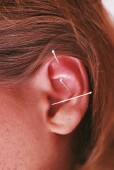
MONDAY, Sept. 10 (HealthDay News) — When it comes to the relief of chronic pain, acupuncture is indeed effective, a sweeping review of previous research finds.
The conclusion stems from a fresh analysis of initial raw data that had been collected by 29 studies previously conducted in Germany, Spain, Sweden, the United States and the United Kingdom. Collectively, these past investigations had involved nearly 18,000 patients.
“We looked at only the best-quality studies,” said study author Andrew Vickers, an attending research methodologist and statistician at the Memorial Sloan-Kettering Cancer Center, in New York City. “So I can say with confidence that what we found is the strongest evidence to date supporting the effectiveness of acupuncture.”
The study appeared online Sept. 10 in the Archives of Internal Medicine.
Acupuncture is age-old Chinese medicinal practice of carefully targeted needle insertion and stimulation at specific points of the body. The review authors acknowledge that although 3 million Americans now undergo acupuncture each year, it’s still the subject of a great deal of debate among Western medicine practitioners with respect to its true therapeutic value.
Many experts theorize that patients who attest to notable pain relief following an acupuncture procedure are simply deriving the benefits of deeply wishful thinking (otherwise known as the “placebo effect”), rather than any true physiological improvements.
The authors of the new study looked at acupuncture’s potential impact on four distinct types of chronic pain that each patient had endured for at least one month: back and neck pain, osteoarthritis, chronic headache (including migraines) and shoulder pain.
All studies included in the review were randomized controlled trials, considered the gold standard of research. As well, all involved a comparison between acupuncture and either “usual care” involving no acupuncture at all or the use of so-called “sham acupuncture.”
Sham acupuncture involved the use of retractable or superficially inserted needles in some instances, or nonworking electrical or laser-based stimulation in others.
The result: When compared against sham interventions or no acupuncture at all, true acupuncture appeared to be “superior” at relieving all four types of pain in question.
Acupuncture was seen to provide more or less equivalent degrees of greater pain relief across all pain types.
How much greater? Vickers and his associates explained that, generally speaking, if a patient was to go on to experience a 30 percent drop in pain while undergoing standard care with no acupuncture intervention, those undergoing “sham acupuncture” seemed to experience about a 43 percent drop, while true acupuncture patients experienced a 50 percent fall-off.
The authors stressed that although the superiority of true acupuncture over sham acupuncture appeared to be relatively small, the real-world choice patients face is not between acupuncture or fake acupuncture but rather between acupuncture or no acupuncture at all. And in that context they suggested that their findings are “of major importance for clinical practice.”
“Basically what we see here is that the pain relief difference from acupuncture versus no acupuncture is notable, and important, and difficult to ignore,” Vickers said.
However, he cautioned that though the analysis suggests that acupuncture is a “reasonable” pain relief option, interested patients should make sure to seek out a qualified practitioner, perhaps by getting a reliable referral from their general practitioner.
For his part, Dr. Ed Ross, director of the pain management center at Brigham and Women’s Hospital, in Boston, suggested that while acupuncture may work for some it may not work for all.
“There is clearly a response to acupuncture among a selected patient population,” he said. “And for this seemingly small subset I think it’s a viable treatment for chronic pain. However, in general, the studies that have looked into this have not been considered to be particularly scientifically rigorous. So it’s been really difficult to say who will be in that subset that will benefit.”
“So I would say try it, and if it works, great,” Ross added. “But I also believe in an interdisciplinary approach to pain management. So acupuncture should be considered as only one part of a whole treatment plan.”
Because costs for an acupuncture session vary so widely, neither expert could offer a price estimate. At present, most insurance does not cover acupuncture.
More information
To learn more about acupuncture, visit the U.S. National Center for Complementary and Alternative Medicine

